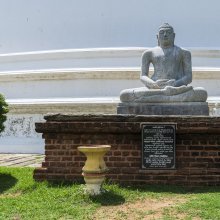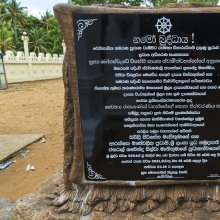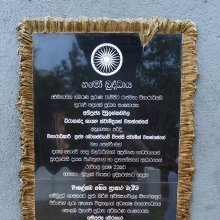Anusasana, Anusāsana, Anushasana: 21 definitions
Introduction:
Anusasana means something in Buddhism, Pali, Hinduism, Sanskrit, the history of ancient India, Marathi, Jainism, Prakrit, Hindi. If you want to know the exact meaning, history, etymology or English translation of this term then check out the descriptions on this page. Add your comment or reference to a book if you want to contribute to this summary article.
Alternative spellings of this word include Anushasan.
Images (photo gallery)
(+2 more images available)
In Hinduism
Vyakarana (Sanskrit grammar)
Source: Wikisource: A dictionary of Sanskrit grammarAnuśāsana (अनुशासन).—Traditional instruction; treat--ment of a topic; e.g. अथ शब्दानुशासनम् (atha śabdānuśāsanam) M. Bh. I. 1.1 where the word is explained as अनुशिष्यन्ते संस्क्रियन्ते व्युत्पा-द्यन्ते अनेन इति अनुशासनम् (anuśiṣyante saṃskriyante vyutpā-dyante anena iti anuśāsanam).

Vyakarana (व्याकरण, vyākaraṇa) refers to Sanskrit grammar and represents one of the six additional sciences (vedanga) to be studied along with the Vedas. Vyakarana concerns itself with the rules of Sanskrit grammar and linguistic analysis in order to establish the correct context of words and sentences.
In Buddhism
Mahayana (major branch of Buddhism)
Source: academia.edu: A Study and Translation of the GaganagañjaparipṛcchāAnuśāsana (अनुशासन) refers to “instruction”, according to the Gaganagañjaparipṛcchā: the eighth chapter of the Mahāsaṃnipāta (a collection of Mahāyāna Buddhist Sūtras).—Accordingly as The Lord said: “O Śāriputra, in the buddha-field of the Tathāgata Ekaratnavyūha, there is a Bodhisattva, the great being Gaganagañja who is resplendent by the splendor of merit (puṇya-tejas), [...] who has been freed from faulty grammar as adorned with complete teaching, perfected his practice as adorned with admonition and instruction (avavāda-anuśāsana), has shown all liberations by pure magic as adorned with miracles (ṛddhi-prātihārya), [...]”.

Mahayana (महायान, mahāyāna) is a major branch of Buddhism focusing on the path of a Bodhisattva (spiritual aspirants/ enlightened beings). Extant literature is vast and primarely composed in the Sanskrit language. There are many sūtras of which some of the earliest are the various Prajñāpāramitā sūtras.
India history and geography
Source: Cologne Digital Sanskrit Dictionaries: Indian Epigraphical GlossaryAnuśāsana or Anuśāsanā.—(CII 1), same as anuśasti, inculcation. Note: anuśāsana is defined in the “Indian epigraphical glossary” as it can be found on ancient inscriptions commonly written in Sanskrit, Prakrit or Dravidian languages.

The history of India traces the identification of countries, villages, towns and other regions of India, as well as mythology, zoology, royal dynasties, rulers, tribes, local festivities and traditions and regional languages. Ancient India enjoyed religious freedom and encourages the path of Dharma, a concept common to Buddhism, Hinduism, and Jainism.
Languages of India and abroad
Pali-English dictionary
Source: BuddhaSasana: Concise Pali-English Dictionaryanusāsana : (nt.) advice; instruction; admonition.
Source: Sutta: The Pali Text Society's Pali-English DictionaryAnusāsana, (nt.) (Vedic anuśāsana, fr. anu + śās) advice, instruction, admonition D.III, 107; A.I, 292 (°pāṭihāriya, cp. anusāsanī); Miln.359. (Page 44)

Pali is the language of the Tipiṭaka, which is the sacred canon of Theravāda Buddhism and contains much of the Buddha’s speech. Closeley related to Sanskrit, both languages are used interchangeably between religions.
Marathi-English dictionary
Source: DDSA: The Molesworth Marathi and English Dictionaryanuśāsana (अनुशासन).—n (S) Regulating or determining; binding under rules or laws. 2 The laws or rules prescribed.
Source: DDSA: The Aryabhusan school dictionary, Marathi-Englishanuśāsana (अनुशासन).—, n Advice, instruction. Precept, rule, law.
Marathi is an Indo-European language having over 70 million native speakers people in (predominantly) Maharashtra India. Marathi, like many other Indo-Aryan languages, evolved from early forms of Prakrit, which itself is a subset of Sanskrit, one of the most ancient languages of the world.
Sanskrit dictionary
Source: DDSA: The practical Sanskrit-English dictionaryAnuśāsana (अनुशासन).—Advice, persuasion, direction, order. command; instruction, laying down rules or precepts; a law, rule, precept; treatment (of a subject), (with the object in comp. or with gen., the agent, if expressed, being put in the instr. or gen.); एतद्वै भद्रमनुशासनस्य (etadvai bhadramanuśāsanasya) Ṛgveda 1.32.7. एतदनुशासनम् (etadanuśāsanam) Tait. Up.7.9.7. भवत्यधिक्षेप इवानुशासनम् (bhavatyadhikṣepa ivānuśāsanam) Kirātārjunīya 1.28 words of advice; तन्मनोरनुशासनम् (tanmanoranuśāsanam) Manusmṛti 8.139;6.5;2.159; यौवन° (yauvana°) K.146; नामलिङ्ग° (nāmaliṅga°) laying down rules on the gender of nouns, explanation of gender &c.; शब्दानुशासनम् (śabdānuśāsanam) Sk.; शब्दानामनुशासनमाचार्यस्य आचार्येण वा (śabdānāmanuśāsanamācāryasya ācāryeṇa vā) P.II.3.66 Sk.
Derivable forms: anuśāsanam (अनुशासनम्).
Source: Cologne Digital Sanskrit Dictionaries: Edgerton Buddhist Hybrid Sanskrit DictionaryAnuśāsanā (अनुशासना).—(= °nī, q.v.), instruction: Mahāvyutpatti 1439; [Jātakamālā 29.5 °nāṃ, ed. by em., all mss. °nīṃ].
Source: Cologne Digital Sanskrit Dictionaries: Shabda-Sagara Sanskrit-English DictionaryAnuśāsana (अनुशासन).—n.
(-naṃ) Command, order, precept, law. E. anu, and śāsana ruling.
Source: Cologne Digital Sanskrit Dictionaries: Benfey Sanskrit-English DictionaryAnuśāsana (अनुशासन).—[anu-śās + ana], n. 1. Instruction, [Mānavadharmaśāstra] 2, 159. 2. Precept, [Mānavadharmaśāstra] 8, 139. 3. Explanation, [Mānavadharmaśāstra] 6, 50.
Source: Cologne Digital Sanskrit Dictionaries: Cappeller Sanskrit-English DictionaryAnuśāsana (अनुशासन).—[neuter] instruction, precept, command.
Source: Cologne Digital Sanskrit Dictionaries: Monier-Williams Sanskrit-English DictionaryAnuśāsana (अनुशासन):—[=anu-śāsana] [from anu-śās] n. instruction, direction, command, precept, [Ṛg-veda x, 32, 7, etc.]
Source: Cologne Digital Sanskrit Dictionaries: Goldstücker Sanskrit-English DictionaryAnuśāsana (अनुशासन):—[tatpurusha compound] n.
(-nam) 1) Instruction, order, precept; e. g. tanmanoranuśāsanam or bhavādṛśeṣu pramadājanoditaṃ bhavatyadhikṣepa ivānuśāsanam; the 13th book of the Mahābh. is called the book of precepts ‘anuśāsanaparvan’.
2) Explanation, comment, explanatory treatise; e. g. yogānuśāsana which is thus explained: yuktiryogaḥ samādhānam . anuśiṣyate vyākhyāyate lakṣaṇabhedopāyaphalairyena tadanuśāsanam .. E. śās with anu, kṛt aff. lyuṭ.
Source: Cologne Digital Sanskrit Dictionaries: Yates Sanskrit-English DictionaryAnuśāsana (अनुशासन):—[anu-śāsana] (naṃ) 1. n. Order, law. Also anuśāstiḥ f.
Source: DDSA: Paia-sadda-mahannavo; a comprehensive Prakrit Hindi dictionary (S)Anuśāsana (अनुशासन) in the Sanskrit language is related to the Prakrit words: Aṇusāsaṇa, Aṇusāsaṇā.
[Sanskrit to German]
Sanskrit, also spelled संस्कृतम् (saṃskṛtam), is an ancient language of India commonly seen as the grandmother of the Indo-European language family (even English!). Closely allied with Prakrit and Pali, Sanskrit is more exhaustive in both grammar and terms and has the most extensive collection of literature in the world, greatly surpassing its sister-languages Greek and Latin.
Hindi dictionary
Source: DDSA: A practical Hindi-English dictionaryAnuśāsana (अनुशासन) [Also spelled anushasan]:—(nm) discipline; ~[śāsaka] a disciplinarian; ~[śāsanabaddha] disciplined; ~[śāsanika, ~śāsanīya] disciplinary; ~[śāsī] disciplinarian, pertaining to discipline, disciplinary.
...
Prakrit-English dictionary
Source: DDSA: Paia-sadda-mahannavo; a comprehensive Prakrit Hindi dictionary1) Aṇusāsaṇa (अणुसासण) in the Prakrit language is related to the Sanskrit word: Anuśāsana.
2) Aṇusāsaṇā (अणुसासणा) also relates to the Sanskrit word: Anuśāsanā.
Prakrit is an ancient language closely associated with both Pali and Sanskrit. Jain literature is often composed in this language or sub-dialects, such as the Agamas and their commentaries which are written in Ardhamagadhi and Maharashtri Prakrit. The earliest extant texts can be dated to as early as the 4th century BCE although core portions might be older.
Kannada-English dictionary
Source: Alar: Kannada-English corpusAnuśāsana (ಅನುಶಾಸನ):—
1) [noun] a restricting or being restricted; a preventing or suppressing and controlling, some action, either by authority of law or by force; restriction; restrain.
2) [noun] a regulation, rule, that so restricts.
3) [noun] act or process of giving instruction or educating.
4) [noun] punishment a) a punishing or being punished; b) a penalty imposed on an offender for a crime or wrongdoing.
Kannada is a Dravidian language (as opposed to the Indo-European language family) mainly spoken in the southwestern region of India.
See also (Relevant definitions)
Partial matches: Shasana, Anu.
Starts with: Anushasanapara, Anushasanaparva, Anushasanaparvan.
Ends with (+10): Asadanushasana, Ashtadashavivadanushasana, Atmanushasana, Bhashanushasana, Bhojadevashabdanushasana, Chandonushasana, Chhandonushasana, Darshananushasana, Dhanurasana, Kavyanushasana, Laghushabdanushasana, Linganushasana, Namalinganushasana, Namanushasana, Nanarthashabdanushasana, Padanushasana, Paniniyalinganushasana, Parshvadhanurasana, Prakritanamalinganushasana, Purusharthanushasana.
Full-text (+481): Anushasanapara, Pithana, Anushasan, Anusatthi, Namalinga, Bhishmasvargarohanaparva, Anushasani, Pradata, Pundariyaka, Karta, Pratita, Punyakrit, Tantu, Dipti, Divyasanu, Anugopta, Camohara, Divyakarmakrit, Trikakubdhama, Anukarma.
Relevant text
Search found 31 books and stories containing Anusasana, Anusāsana, Anushasana, Anuśāsana, Anuśāsanā, Anu-shasana, Anu-śāsana, Anu-sasana, Aṇusāsaṇa, Aṇusāsaṇā, Anushasasana, Anuśasasana, Anusasasana; (plurals include: Anusasanas, Anusāsanas, Anushasanas, Anuśāsanas, Anuśāsanās, shasanas, śāsanas, sasanas, Aṇusāsaṇas, Aṇusāsaṇās, Anushasasanas, Anuśasasanas, Anusasasanas). You can also click to the full overview containing English textual excerpts. Below are direct links for the most relevant articles:
Puranic encyclopaedia (by Vettam Mani)
Animal Kingdom (Tiryak) in Epics (by Saranya P.S)
Chapter 6.3 - The hawk-dove debate (Shyena Kapota Samvada)
Chapter 6.4 - The Jackal-monkey debate (Shrigala Vanara Samvada)
Chapter 6.2 - Kitopakhyana—The argument between Vyasa and a worm
Formal Education System in Ancient India (by Sushmita Nath)
Subjects studied in the Brahmanic Period < [Chapter 5 - Subjects studied in the Vedic and Buddhist period]
Education in the Brahmanic Period < [Chapter 1 - Introduction]
Mahabharata (English) (by Kisari Mohan Ganguli)
Section XXXV < [Anusasanika Parva]
Section CLXVIII < [Anusasanika Parva]
The history of Andhra country (1000 AD - 1500 AD) (by Yashoda Devi)
Introduction (Haihaya dynasty) < [Chapter II - The Haihayas]
Yoga-sutras (with Vyasa and Vachaspati Mishra) (by Rama Prasada)
Sūtra 1.1 < [Book 1 - Trance (Samādhi)]
Related products







